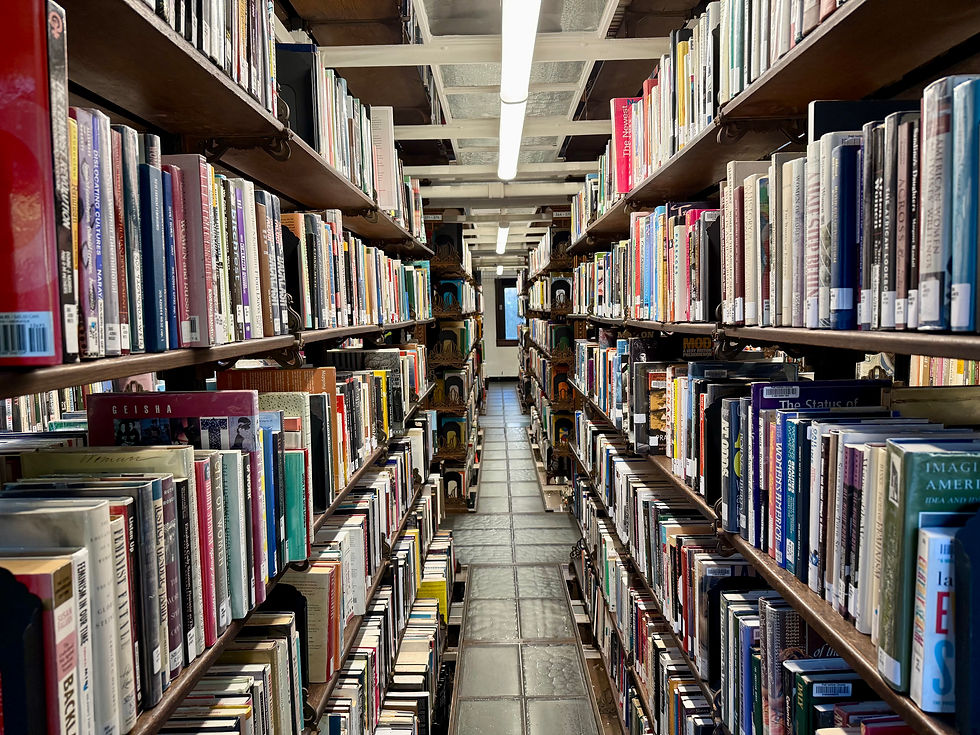From Divine Light to Domestic Beauty: The Medieval Media Revolution That Changed Everything
- Eduardo Montes-Bradley

- Aug 29
- 6 min read
Updated: Sep 9
How the world’s first broadcast technology evolved into America’s most beloved art form
Picture this: You’re a peasant in 1140, stepping into Chartres Cathedral for the first time. Suddenly, the stone walls explode into moving rivers of red and blue light. Biblical stories unfold in glowing panels around you as the “programming” shifts with the sun’s movement. You’re witnessing the world’s most advanced projection system—centuries before anyone dreamed of television.
This wasn’t just religious art. Medieval churches had created humanity’s first mass media empire, using sunlight as their transmission medium and colored glass as their broadcast technology. The stained glass windows were literally projection systems, casting programmed content across cathedral interiors to audiences who had never experienced anything remotely like it.
But here’s the twist: this revolutionary media technology would eventually escape the church’s monopoly and transform into something completely different—the intimate, nature-inspired beauty of Tiffany lamps glowing in American living rooms.

The Sacred Trinity of Light Architecture
Around 1140, Abbot Suger at Saint-Denis cracked the code for creating truly transcendent experiences. His secret wasn’t just theological—it was technological. He discovered that three elements working in perfect harmony could literally transport human consciousness:
Mystical Theology (Divine Source)
Suger drew inspiration from Pseudo-Dionysius, who taught that physical light was divine presence made visible. This wasn’t metaphor—medieval thinkers believed actual sunlight streaming through windows could elevate souls toward God. Every ray had spiritual purpose. Suger wrote that his windows should “brighten the minds, so that they may travel, through the true lights, to the True Light where Christ is the true door.”
Gothic Architecture (Divine Made Manifest)
Gothic architecture became the structural solution that made walls of light possible. Flying buttresses, pointed arches, and ribbed vaults weren’t just beautiful—they were engineering innovations that let architects dissolve solid stone barriers and replace them with luminous glass membranes. Now, for the first time, buildings could be designed around light rather than despite it.
Glass Chemistry (Divine Illumination)
Medieval craftsmen developed glass-making techniques so sophisticated we’re only now understanding them through electron microscopy. They engineered copper nanoparticles for ruby glass, created multi-layered structures for optimal light transmission, and developed grisaille windows specifically to “introduce a larger amount of light.” These weren’t just artisans—they were optical engineers, guided by faith but grounded in physics. (1)
The Science Behind the Sacred

Recent analysis reveals the precision underlying medieval intuition. Using high dynamic range imaging, researchers discovered that 12th-century glass admitted significantly more light than 13th-century glass, while 15th-16th century glass increased transmission “by as much as an order of magnitude.”
The medieval craftsmen instinctively understood what we now measure scientifically: different glass compositions create dramatically different relationships with natural light. They were engineering specific luminous environments designed to trigger transcendent experiences.
The trinity worked because each element served the others. The theology demanded maximum light, which required innovative architecture, which necessitated advanced chemistry. The result was humanity’s first fully immersive experiences—spaces that felt genuinely otherworldly to anyone who entered them.
From Divine Light to Domestic Beauty
In the 1880s, Louis Comfort Tiffany looking at this 700-year-old tradition would asked: “What if we could bring this magic into people’s daily lives, and into their homes?” The question lead Tiffany to reimagined the medieval trinity for a new world.
The Great Transformation
From Divine Theology → Personal Aesthetics
Instead of channeling God’s presence, Tiffany believed “nature should be the primary source of design inspiration.” His windows captured “the lush palette found in flowers and plants” rather than biblical narratives. Beauty became the new sacred.
From Cathedral Architecture → Interior Design
Instead of transforming vast sacred spaces, Tiffany focused on “controlling natural and artificial light” in private homes. He decorated Mark Twain’s house, redesigned the White House, and pioneered the concept of lifestyle design—curating personal environments for aesthetic pleasure rather than spiritual transformation.
From Sacred Chemistry → Commercial Innovation
Instead of mystical craft traditions, Tiffany created systematic production. His studios employed over 300 artisans, becoming “the largest producer of stained-glass windows in the nation,” turning spiritual craft into American industry.(2)
Revolutionary Glass Technology
Tiffany’s breakthrough was opalescent glass—material that was “radically different from pot metal” and “fabulously varied in color and texture—even within a single piece of glass.”
While medieval glass was engineered for maximum transparency (to let divine light flood in), Tiffany’s glass was designed to transform light—diffusing, mixing, and softening it to create intimate ambiance rather than transcendent brightness.
His copper foil technique allowed “a level of detail previously unknown,” enabling intricate organic patterns that medieval lead construction couldn’t achieve. Where medieval craftsmen sought clarity and brilliance, Tiffany pursued complexity and subtlety—glass that could “mimic foliage, fabric, water, or a sunlit horizon.”
From Collective Transcendence to Personal Beauty
The shift was groundbreaking. Medieval light was about surrender to something greater—entire communities gathering to encounter the divine (The exquiscit?) together. Tiffany’s light was about individual comfort and daily aesthetic pleasure.
Medieval immersion was designed for spiritual transformation. Tiffany’s immersion was designed for lifestyle enhancement.
The Modern Legacy: Why This Evolution Matters
Understanding this progression from sacred broadcasting to domestic beauty reveals why both traditions remain essential:
The DNA of Experience Design
Medieval stained glass pioneered what we now call immersive experience design. Every modern installation—from museum exhibits to theme park attractions—traces its conceptual ancestry back to those 12th-century experiments in environmental storytelling through light.
Tiffany democratized that technology, proving that transcendent beauty didn’t require cathedral-scale spaces or religious context. His innovations showed that carefully crafted light could transform any environment, making the extraordinary available in ordinary daily life.
Technological Heritage
Medieval craftsmen developed copper nanoparticle technology eight centuries before we had scientific vocabulary to understand it. Tiffany pioneered opalescent glass techniques that modern artisans still struggle to replicate.
These aren’t just art objects—they’re repositories of lost technologies, frozen laboratories showing us what’s possible when human creativity pushes the boundaries of materials and light.
The Evolution of Human Consciousness
The journey from Suger’s divine light theology to Tiffany’s domestic aesthetics documents a fundamental shift in how we seek meaning and beauty. Medieval churches taught communities to reach toward transcendence together. Tiffany lamps taught individuals to cultivate beauty in personal daily life.
Both approaches remain essential to human flourishing. We still need experiences that lift us beyond ourselves, and we still need beauty that enriches our everyday environments.
Preserving the Light: Why “Tiffany in the Wild” Matters
Original Tiffany pieces surviving in their intended environments—private homes, historic buildings, unexpected public spaces—preserve something museums can’t replicate: the complete experience as originally conceived.
A Tiffany window catching natural light in its original domestic setting creates entirely different optical effects than the same piece under artificial museum lighting. These “wild” installations continue evolving naturally, developing patinas and light relationships that teach us about long-term material behavior.
Moreover, they preserve the full ecosystem of Tiffany’s vision: not just the glass object, but the architectural context, natural light patterns, and intimate scale that made his domestic revolution possible.
When we lose these works, we lose more than beautiful objects. We lose functioning examples of humanity’s ongoing quest to make light serve beauty, meaning, and wonder—whether in medieval cathedrals designed to channel divine presence or Tiffany lamps crafted to bring nature’s beauty into our homes.
The light that first broadcast divine messages at Saint-Denis in 1140 continues transmitting today in every original Tiffany piece still glowing in someone’s living room. Both traditions deserve our protection, study, and amazement—reminders that humans have always found ways to make light itself a carrier of beauty and meaning.
Notes
Kunicki-Goldfinger et al. in Journal of Archaeological Science and Dörfler et al. on copper nanoparticles in Optical Materials.
Metropolitan Museum's official publication stating that Tiffany Glass Company was "the largest producer of stained-glass windows in the nation" in the 1880s.
Tiffany in the Wild is a documentary journey into the stained glass and mosaics of Louis Comfort Tiffany, experienced as they were meant to be seen — in the churches, cemeteries, libraries, and civic landmarks where they continue to interact with light, space, and community.
From Boston’s Arlington Street Church to New York’s Woodlawn Cemetery, from Philadelphia’s Dream Garden to the stage curtain of Mexico City’s Palacio de Bellas Artes, the film follows Tiffany’s art across borders and through time. It concludes in Chicago beneath the vast mosaic dome of Marshall Field’s, where commerce itself was transformed into civic theater.
More than a study of decorative glass, Tiffany in the Wild is a meditation on how art and light shape the way we worship, learn, remember, and live together.









Comments